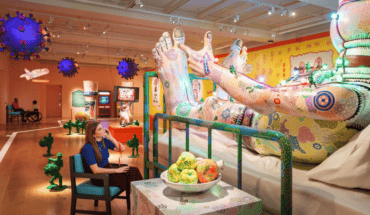Whether it’s a twinge in the small of your back or an eye-watering ache in your lumbar spine, back pain is a modern epidemic. Most people experience a brief, acute episode of mechanical back pain – muscle strain that will resolve itself within days if not weeks. But others can endure chronic pain for months or even years and can find their quality of life is severely affected. It’s a costly health issue too. Figures released by the UK Statistics Authority reveal that around 4.2 million working days were lost by workers aged 50-64 alone in 2014.
Those aged 25-34 were absent for 1.89 million days due to back pain, while those in the 35-49 bracket missed 3.86million days in the office and the total cost of the missed work days amounts to more than a billion pounds.
What used to be regarded as an old person’s ailment moreover now affects younger people. One in three 16 to 24-year-olds and almost half of 45 to 64-year-olds suffer from back pain.
The good news is that the majority of back pain instances are temporary. They are caused by strain on the muscles and ligaments that support the vertebrae and are usually triggered by picking up a heavy weight or twisting the spine in some way. But any pain is greatly exacerbated by a variety of postural bad habits; compressing the spine by slouching at a desk or wheel of a car, lifting heavy loads incorrectly or standing badly. Even a heavy handbag slung over a shoulder will eventually take its toll.
According to osteopath Barrie Savory, the location of back pain gives a clear indication of where the root of the problem lies. “Back pain is about two ends and a middle,” he says. “Lower back problems are about coping with standing upright. Middle back problems are about posture and upper back problems are about
spending too long sitting at a PC, in a car or even breastfeeding in the wrong position.” Savory, author of The Good Back Guide believes that when we sit at a desk all day, our body memorises the muscle pattern of the hunched shape we adopt, which then becomes imprinted indelibly. “To use a computer analogy, the thing most people do that leads to a lifetime of postural pain, is to run ‘desk mode’ while they are standing upright,” he says. “They stand up with the upper back still slumped over an invisible desk; merely curving in at the lower back and neck to assume some semblance of an upright posture. “If you don’t want that to happen, you have to learn to click out of ‘desk mode’ and into ‘upright mode’, by giving your brain a very simple input signal.” The signal is a stretch that takes seconds. Stand with your hands behind your back, interlock your fingers and pull back your shoulders. Try to feel your shoulder blades meeting at the back and your chest open out in front of you. “You need only do it for five seconds, but that’s enough time to “click off” one mode and engage another. If a person does it every time they leave their desk, I can promise a profound change.” Increasing overall fitness will have a positive effect on back pain. Other ways of specifically improving back strength and flexibility include building core muscle strength using simple exercises, such as those employed in Pilates. Research published in the American Annals of Internal Medicine last year suggested that back pain sufferers recovered faster and experienced fewer debilitating symptoms if treated with a course of yoga instead of conventional exercise regimes. A Swedish study in The Clinical Journal of Pain also indicated that acupuncture can provide long-term relief for low back pain.
Discogenic back pain can be another cause of chronic discomfort and results from the degeneration of the discs between the vertebrae, which impairs their ability to act as shock absorbers for the spine. Nerves between the vertebrae can become pinched, leading to intense pain. Steroid injections are usually the recommended treatment, along with an exercise regime to strengthen the spine and improve suppleness. Where non-surgical treatments don’t provide relief, spinal fusion surgery may be recommended. This is where the spine is realigned and a bone graft inserted. The vertebrae are held in place with a screw system until the graft fuses with the vertebrae. This holds the vertebrae together, preventing motion in the area and so reducing pain. Spinal stenosis is another age-related condition which tends to affect the over 60s, where the nerve openings around the spinal chord or nerve roots narrow, causing symptoms similar to a pinched nerve. The pain is described as an aching or an electrical tingling down the arm. Again steroids, physiotherapy, exercise and weight loss would be typically recommended and surgery only considered as a last resort. Around ten per cent of back pain can be attributed to degenerative conditions such as osteoporosis, where bones lose density and are weakened and arthritis, where joints become inflamed, causing pain, swelling and stiffness. Persistent back pain can often occur due to arthritis of the facet joints, which are the joints between the vertebrae and degeneration of the discs, sometimes referred to as spondylosis, but many people with very worn discs and joints experience no pain whatsoever. Anti-inflammatory drugs and exercise can often keep arthritic symptoms under control. Osteoporosis is treated with drugs, which often hormone-based, and weight-bearing exercises such as walking are also recommended. While sufferers of these conditions will invariably be under close medical supervision, for the rest of us it can be difficult to know when to see our doctor about back pain. There are a number of warning signs that may indicate a need for swift medical attention, such as prolonged pain that doesn’t abate over several days or is keeping you awake at night. If you have a fever, chills, sweats or other signs of infection together with back pain, you should consult your GP immediately. If back pain is accompanied by difficulties controlling your bowels or bladder this could indicate cauda equina syndrome, a rare but serious condition, where the nerves at the base of the spine are being compressed. Anyone with these symptoms should seek help as a matter of urgency. As with all medical matters, however, prevention is better than a cure. According to Sammy Margo, spokeswoman for the Chartered Society of Physiotherapists, the basic guidelines are commonsensical; keep your weight down, your general fitness up and don’t sit rigid at your desk for eight hours a day. “We need to be a lot more pro-active rather than reactive,” says Margo. “It’s all about getting moving a little and often; it can be as simple as putting the wastepaper basket across the other side of the room so you have to stand up to reach it, or getting off one stop early on the bus or train and walking to work. “If you sit all day every day and then occasionally go to the gym for an explosive workout, you can do yourself more harm than good. The key to a healthy back is integrating movement into all aspects of your life.”
- Biden Declines Second Term: Health Concerns - 23rd July 2024
- New catheter coating stops bacteria cells from swarming - 10th June 2024
- AI-designed catheters could dramatically reduce urinary tract infections - 10th June 2024






